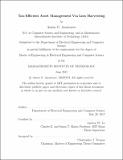| dc.contributor.advisor | Andrew W. Lo. | en_US |
| dc.contributor.author | Anastasov, Anton G | en_US |
| dc.contributor.other | Massachusetts Institute of Technology. Department of Electrical Engineering and Computer Science. | en_US |
| dc.date.accessioned | 2017-12-20T17:24:24Z | |
| dc.date.available | 2017-12-20T17:24:24Z | |
| dc.date.copyright | 2017 | en_US |
| dc.date.issued | 2017 | en_US |
| dc.identifier.uri | http://hdl.handle.net/1721.1/112829 | |
| dc.description | Thesis: M. Eng., Massachusetts Institute of Technology, Department of Electrical Engineering and Computer Science, 2017. | en_US |
| dc.description | This electronic version was submitted by the student author. The certified thesis is available in the Institute Archives and Special Collections. | en_US |
| dc.description | Cataloged from student-submitted PDF version of thesis. | en_US |
| dc.description | Includes bibliographical references (page 63). | en_US |
| dc.description.abstract | In this thesis, we study loss-harvesting--an investment strategy that realizes capital losses immediately but defers realizing capital gains as long as possible. We begin by describing a computational framework for studying the properties of loss-harvesting empirically. The main advantage of our framework is flexibility. In particular, our framework is independent of any particular choice of a source for stock return time series. After combining the framework with the Capital Asset Pricing Model as a source for simulated stock returns data, we perform a thorough sensitivity analysis and study the performance of loss-harvesting under various conditions of the financial market. By combining the framework with historical stock return time series from the S&P 500 Index, we study the performance of loss-harvesting from a different and more practical, point of view. Through this empirical exploration, we identify three new findings about loss-harvesting: (1) introducing a transaction cost rate of 1% reduces alpha by about 50% after taxes; (2) introducing regular cash contributions reduces alpha after taxes; and (3) under specific market conditions, a simple passive buy-and-hold investment strategy outperforms loss-harvesting. | en_US |
| dc.description.statementofresponsibility | by Anton G. Anastasov. | en_US |
| dc.format.extent | 63 pages | en_US |
| dc.language.iso | eng | en_US |
| dc.publisher | Massachusetts Institute of Technology | en_US |
| dc.rights | MIT theses are protected by copyright. They may be viewed, downloaded, or printed from this source but further reproduction or distribution in any format is prohibited without written permission. | en_US |
| dc.rights.uri | http://dspace.mit.edu/handle/1721.1/7582 | en_US |
| dc.subject | Electrical Engineering and Computer Science. | en_US |
| dc.title | Tax-efficient asset management via loss harvesting | en_US |
| dc.type | Thesis | en_US |
| dc.description.degree | M. Eng. | en_US |
| dc.contributor.department | Massachusetts Institute of Technology. Department of Electrical Engineering and Computer Science | |
| dc.identifier.oclc | 1015182911 | en_US |
